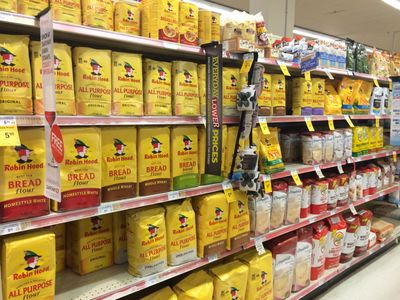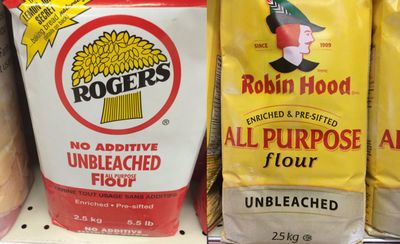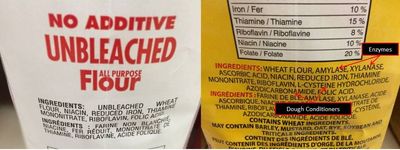
Flour's simple, right? It's ground up wheat, is all. So why is the baking aisle so confusing?
In the last lesson, I told you all about the basic tools you need to bake great bread at home. Now it's time to talk about ingredients.
Flour is the most important ingredient in your loaf, so it's worth thinking about what flour to use. There are a thousand options available on-line or in specialty markets, but for now let's focus on picking the best flour to buy at the grocery store. It's not as easy as it looks!
The Best Flour to Buy at the Grocery Store #
While you can bake great bread with just about any wheat flour (and some non-wheat flours), there is good flour and there is great flour!
The flour that is closest to what we use at Orange Boot Bakery is Unbleached, Untreated All Purpose Flour.
Let's dig into the bag a little and figure out what that means.
Unbleached Flour Preserves Colour and Flavour #

Two unbleached flours from the local Safeway: Rogers and Robin Hood
First off, strive to purchase unbleached flour. Bleached flour is a throwback to our ancestor's obsession with whiteness and the needs of bread factories. Bleaching flour destroys the creamy colour of flour and kills off some of the flavour.
Bleaching oxidizes the flour, which means it can be used in the factory right after milling. That's important if you're buying flour by the tanker truck. But for us, the time it took to get the flour from the mill to the store (and to your kitchen) is good enough.
Avoid Added Dough Conditioners #

Second, turn the bag sideways and look closely at the "ingredients" part of the label. We want wheat flour and nothing but wheat flour.
For good reason, the government forces millers to replace vitamins and minerals that were removed from the flour during milling (the bran is removed when milling white flour and the bran contains most of the minerals.) So you'll see a few other items on the label and that's OK.
The following are vitamins and mineral that you'll see on the label: thiamin, riboflavin, niacin, folic acid and iron. Sometimes calcium gets added too.
You want to avoid dough conditioners, like L-Cysteine and azodicarbonamide(ADA.) These are added to make bread dough easier to put through the big machines in bread factories. Completely unnecessary for our purposes.
There is a growing concern about the health affects of ADA, so I avoid it in my flour. But other additions - you may see wheat starch and fungal amlayse - aren't as big a concern for me. If that's all I can find, I use it.
(At the bakery, my miller said they added wheat starch into flour to increase shelf life. He could mill larger batches and have it sit in his warehouse for a few extra weeks that way. And fungal amlayse is an enzyme which boosts enzymes already in the flour to do more of what they're already doing: break down starch and gluten, and develop flavour.)
Protein is Important, But You Can Get Too Much #
Finally, a word about protein. Robin Hood especially makes the case that high protein flours make better bread.
That's true, to a point. Robin Hood makes a very high protein "Best for Bread" flour that has between 13% and 14% protein. Awesome for high speed mixers, lightning fast production and fluffy white bread.
But that's not what we're doing here.
A slightly softer flour, around 11% - 12% protein will give you a softer loaf. Also, it will handle the long fermentation times that we use at Orange Boot.
In North America and for sure within Canada, that means All Purpose Flour is preferred over the 'Best for Bread' type of flours.
Organic or Industrial: it's up to you #
There is more and more organic flour available, especially in Saskatchewan, and that's a good thing. We use local organic flour in our bread at Orange Boot Bakery and it's readily available in smaller bags at specialty markets.
However, using organic flour was a personal choice, not a "baking quality" choice. Either will give you good results, so use what you have access to.
Also, organic white flour still needs to be enriched with vitamins and minerals. It's a "white flour" requirement, not an "industrial" requirement.
But if you're shopping at the grocery store, your organic flour choices are extremely limited. We'll cover specialty and mail order sources in future lessons.
Flour Recap #
So to recap, the four things you're looking for when selecting a white flour:
- Unbleached
- Untreated (avoid L-Cysteine and ADA)
- All Purpose (or 11% - 12% protein)
- Organic or not, it's your choice
Next up: More ingredients. Water, even!